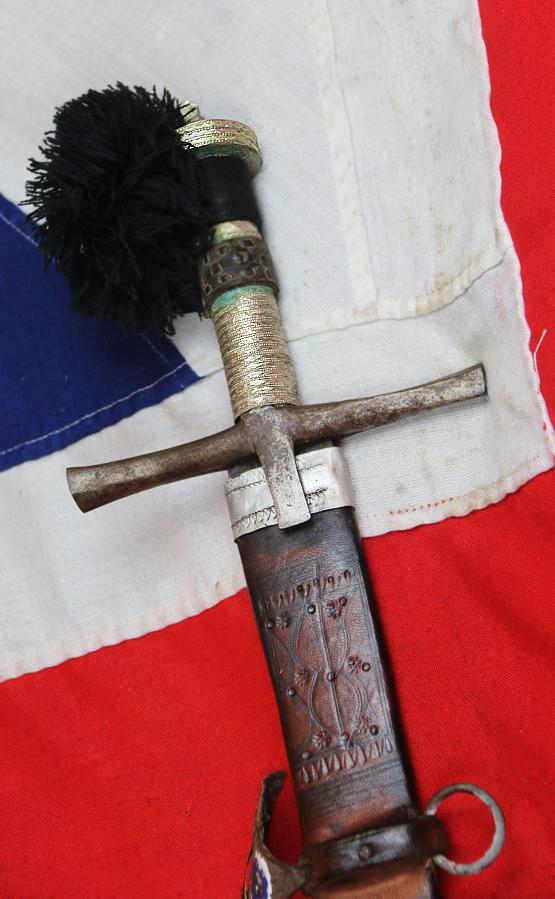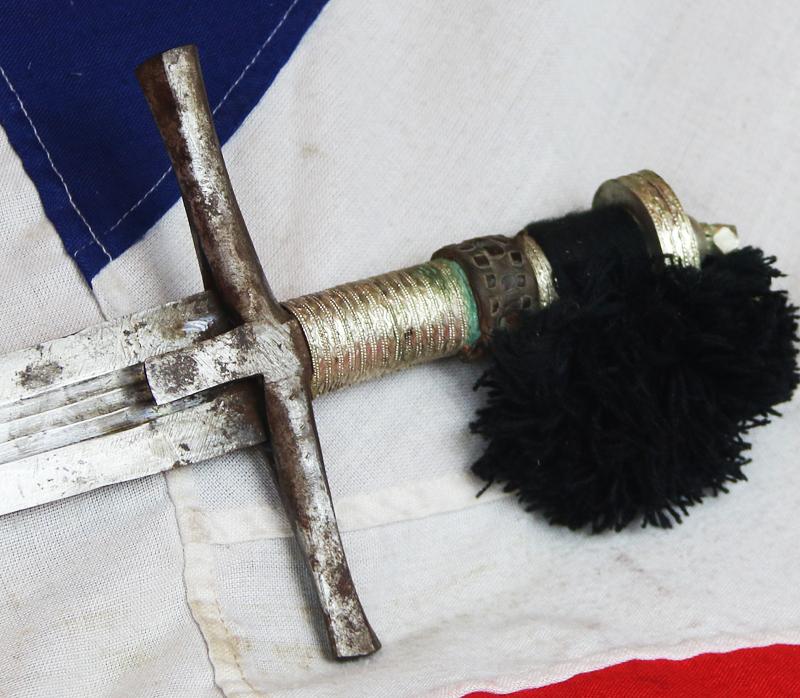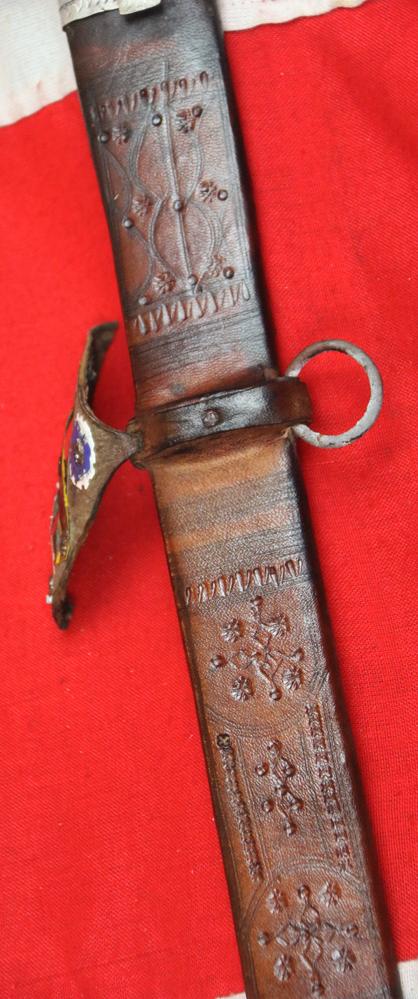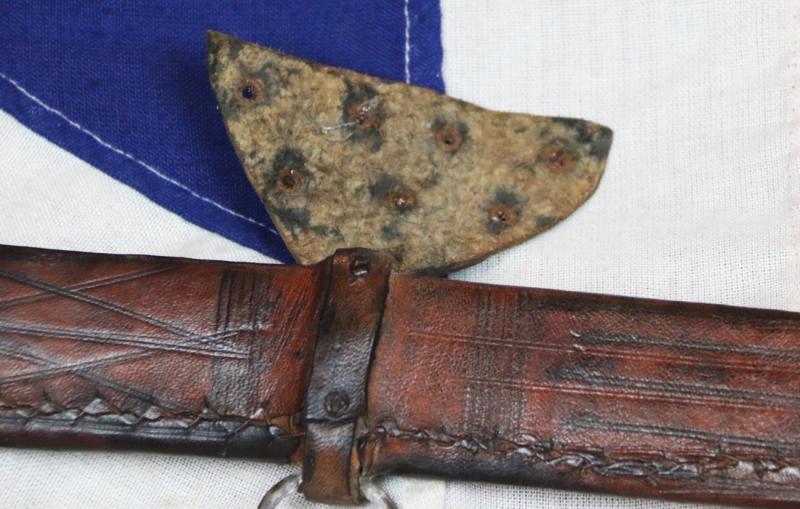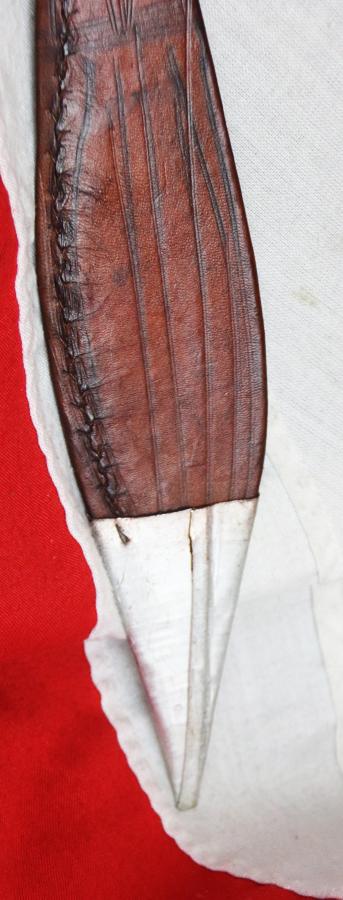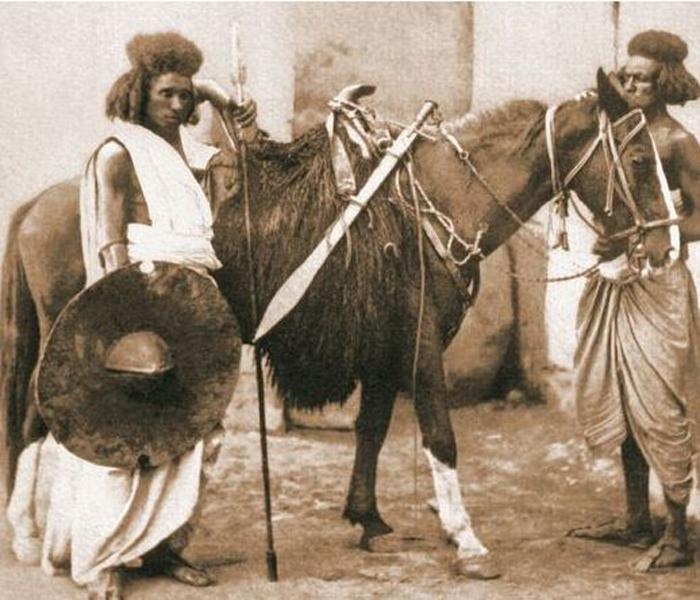Sudanese Kaskara Beja Tribe Sword, with Traditional Embossed Hide Paddle Shaped Scabbard
Sudanese Kaskara Beja Tribe Sword With Silver From Port Sudan Red Sea
The Kaskara was a type of sword characteristic of Sudan, Chad, and Eritrea. The blade of the kaskara was usually about a yard long, double edged and with a spatulate tip. While most surviving examples are from the 19th century, the type is believed to have originated around the early 14th century, and may represent a localized survival of the straight, double-edged medieval Arab sword that itself was influenced by the knightly sword carried by the early crusaders to the Holy Land. In fact the kaskara is the closest representation of a mediaeval knightly sword one can see, in fact the similarities to the cruciform hilted sword of history are so profound that they are near identical. The kaskara was worn horizontally across the back or between the upper arm and thorax. According to British Museum curator Christopher Spring, “in the central and eastern Sudan, from Chad through Darfur and across to the Red Sea province, the straight, double-edged swords known as kaskara were an essential possession of most men.”
The Beja are traditionally Cushitic-speaking pastoral nomads native to northeast Africa, formerly referred to as Blemmyes. A geographer named Abu Nasr Mutahhar al-Maqdisi wrote in the tenth century that the Beja were at that time Christians. Beja territories in the Eastern desert were made tributary by the Kingdom of Aksum in the third century. The Beja were Islamized beginning in the 15th century. The now-Islamic Beja participated in the further Muslim conquest of Sudan, expanding southward. The Hadendoa Beja by the 18th century dominated much of eastern Sudan. In the Mahdist War of the 1880s to 1890s, the Beja fought on both sides, the Hadendoa siding with the Mahdist troops, while the Bisharin and Amarar tribes sided with the British, and some Beni Amer - a subset of the Beja who live largely in modern Eritrea - sided with the Ethiopian Ras Alula in certain battles, such as Kufit.
The three most famous engagements with the forces of the Mahdi were at Khartoum Abu Klea and Omdurman.
Huge broadsword blade with cruciform hilt, the blade has a central fuller with two fullers aside, and the mid section is struck with a pair of armourer's marks. In the 1880’s the Sudan, the vast land just south of Egypt, was ruled by the Khedive from Cairo. Sudan was basically occupied by native Africans in the south and Arab traders in the north. The coming of the Muslim religious leader known as the "Mahdi" unified the population into an uprising against Egypt.
Britain assisted and allowed General Charles Gordon to become the Governor of Sudan on behalf of the Egyptian Khedive. The result was that after a long siege the entire Khartoum garrison, including General Charles Gordon, was butchered leading to much embarrassment for the British Government. It took 14 years, until 1898 for General Gordon to be avenged with the complete destruction of the Muslim Army at the Battle of Omdurman. In this battle In 1898 the 23 year-old Winston Churchill was serving with the 21st Lancers in the Sudan, while earning money on the side as a war correspondent for the Morning Post. While participating in the last British cavalry charge in history at the Battle of Omdurman, he witnessed the bravery of Dublin-born Victoria Cross winner, Private Thomas Byrne. He also became a skin graft donor to the officer that Byrne saved.
The Mahdi army, numbering over 100,000, was made up of many tribes of various origins and used long broad swords fashioned on those the European Crusaders had carried back in the 13th and 14th centuries. These were known as Kaskaras, and were carried along with a large shield.
This Broadsword, known as a Kaskara, is a lovely example of the principal weapon carried by the Mahdi's warriors. These were desert people and had modelled the broadsword on those carried by the European Crusaders in the 14th century.
This particular example is of very nice quality with silver bound hilt and pommel, an overall length of 44" and a huge 34.5 inch blade. Acquired in the early to mid 20th century by a former British officer, but it is unclear, and no longer known, how and when it came into his possession.
The blade has a few aged corrosion areas and a pair of crescent 'faced' moon armourer's stamps, that are pseudo, very early, German armourer's marks. It has been in the workshop for over two days and 18 hours being hand cleaned and conserved, rejuvenating the leather, and removing many decades of surface detritus to the exterior and the blade, being very careful not to over clean and leaving natural surface ageing and patination completely as it should be.
Huge broadsword blade with cruciform hilt, the blade has a central fuller with two fullers aside, and the mid section is struck with a pair of armourer's marks. In the 1880’s the Sudan, the vast land just south of Egypt, was ruled by the Khedive from Cairo. Sudan was basically occupied by native Africans in the south and Arab traders in the north. The coming of the Muslim religious leader known as the "Mahdi" unified the population into an uprising against Egypt.
Britain assisted and allowed General Charles Gordon to become the Governor of Sudan on behalf of the Egyptian Khedive. The result was that after a long siege the entire Khartoum garrison, including General Charles Gordon, was butchered leading to much embarrassment for the British Government. It took 14 years, until 1898 for General Gordon to be avenged with the complete destruction of the Muslim Army at the Battle of Omdurman. In this battle In 1898 the 23 year-old Winston Churchill was serving with the 21st Lancers in the Sudan, while earning money on the side as a war correspondent for the Morning Post. While participating in the last British cavalry charge in history at the Battle of Omdurman, he witnessed the bravery of Dublin-born Victoria Cross winner, Private Thomas Byrne. He also became a skin graft donor to the officer that Byrne saved.
The Mahdi army, numbering over 100,000, was made up of many tribes of various origins and used long broad swords fashioned on those the European Crusaders had carried back in the 13th and 14th centuries. These were known as Kaskaras, and were carried along with a large shield.
The Sudanese Wars are famously remembered in the movies too: Charlton Heston in "Khartoum" and in at least two productions of "The Four Feathers”. The close of the Victorian era was the height of the Great British Empire.
Beja society was traditionally organized into independent kingdoms. According to Al-Yaqubi, there were six such Beja polities that existed between Aswan and Massawa during the 9th century. Among these were the Kingdom of Bazin, Kingdom of Belgin, Kingdom of Jarin, Kingdom of Nagash, Kingdom of Qita'a and Kingdom of Tankish
Code: 24168



